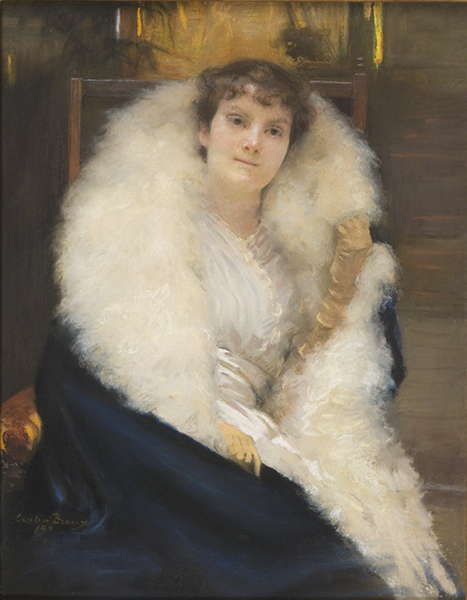May Day Artist Birthday: Cecilia Beaux
The American Renaissance was a period when more American artists traveled to Europe in order to enrich their artistic vision. They brought back such styles as Impressionism, Dark Impressionism, Barbizon Realism, and other influences, all given a distinctly American flair. Cecilia Beaux, next to John Singer Sargent (1856–1925), was one of the most sought-after portrait painters of the American elite during this time.
 |
| Cecilia Beaux (1855–1942, U.S.), Ethel Page (Mrs James Large), 1890. Pastel on paper, 14 ½" x 11 ½" (36.8 x 29.2 cm). Image © 2023 Philadelphia Museum of Art. (PMA-4233) |
In presentation, Beaux’s portraits rival those of Sargent for elegance, informality, and broad, gestural brushwork. Ethel Page—who came from a distinguished Philadelphia family in the lineage of Roger Williams (1603–1683), the founder of the Rhode Island colony—befriended Beaux in 1876. Beaux painted six portraits of Page, and this is perhaps the most light-filled, Impressionistic example.
This work postdates Beaux’s earliest pastel portraits, which she executed in England of the family members of Charles Darwin (1809–1882). The expressive freedom Beaux experienced with the medium found her “in raptures over pastel.” Despite the ease with which she learned the difficult medium, she ultimately thought that pastels best served as studies for her paintings.
Evident in this work, however, is how Beaux used pastels to explore nuanced chromatic harmonies within the white of Page’s dress and fur collar. In the fur, she introduced subtle shades of salmon and yellow to intimate texture. Such effects are also seen in the work of French Impressionist Berthe Morisot (1841–1895) and Mary Cassatt (1844–1926). Like the portraits of Cassatt and Morisot, the gestural rendition of clothing and surroundings contrasts with the sharp-focus treatment of the sitter’s features. Her use of pastels also liberated her backgrounds from dark earth tones to become shimmering, colorful, and suggestive. The background of this work shows the abstract potential that Beaux’s works always flirted with.
The American Renaissance, also called The Gilded Age, roughly corresponds to the period after the Civil War (1860–1865), between the 1870s and 1900. It was a period of massive expansion of the United States into the western part of the American continent, including the growth of cities, expansion of railroads, and increased industrial production. The development of corporations spawned America’s first generation of millionaires. The evolution of a class of American “nobility” led to an incredible flourishing in the arts in the U.S.
Beaux grew up in Philadelphia in a family that encouraged interest in the arts. At a young age, one of her aunts instructed her in watercolors. She began artistic training at 16 with a relative, Catherine Drinker (1841–1922), a realist painter who was the first woman to teach at the Pennsylvania Academy. Beaux also trained with academic Dutch portrait painter Adolf van der Whelen, and later with the American Tonalist painter William Sartain (1843-1924). She also could not escape the dark realism of Thomas Eakins (1844–1916), then Philadelphia’s most prominent portrait painter and a teacher at the Academy.
Under Sartain, Beaux was able to paint from a live model for the first time. Sartain also taught her how to establish form with a few gestural brushstrokes. After great success exhibiting her painting Les derniers jours d’enfance (The Last Days of Childhood) in 1885, she was convinced that it should be her vocation. In a radical move for the times, she decided against marriage, as it would interfere with her artistic career.
The early works of Beaux are stylistically related to the dark portraits of James Abbott McNeill Whistler (1834–1903), although Beaux reveals more interest in the character of her sitters and human relationships. Her palette in the early works was the traditional academic one dominated by browns, blacks, and grays. This changed after her first trip to Paris in 1888, where she saw and admired the work of Sargent, Édouard Manet (1832–1883), and the Impressionists.
Beaux’s greatest admiration was reserved for the masters of Baroque painting and their compositional skill in portraiture. She was also influenced by Jules Bastien-Lepage (1848–1884) and his circle, who worked in a traditional palette but stressed light-filled, atmospheric compositions. They usually emphasized gray, diffused light under overcast skies, which minimized shadows. Beaux, however, consciously avoided any one influence in her work, preferring elements from different styles that she felt suited her work.
By 1890, Beaux had established a studio in New York and soon became a popular painter of society portraits. She won numerous awards for her works from the National Academy of Design and the Pennsylvania Academy of Fine Arts. Starting in 1895, Beaux became the first woman to teach painting full time at the Pennsylvania Academy of Art in Philadelphia.
Compare the portrait of Ethel Page with an earlier version that shows more indebtedness to Bastien-Lepage and Dark Impressionism, rather than Impressionism: nmwa.org/art/collection/ethel-page/.
Correlations to Davis programs: Explorations in Art 2E Grade 1: 2.1, 2.2; Explorations in Art 2E Grade 2: 2.2; Explorations in Art 2E Grade 3: 1.1, 1.2; Explorations in Art 2E Grade 4: 2.1; Explorations in Art 2E Grade 6: 1.1, 1.2, 6.1, 6.2; Experience Art: 1.1, pp.33–37; A Personal Journey 2E: 6.4; Discovering Drawing 3E: Chapter 7; Experience Painting: p. 62


Comments